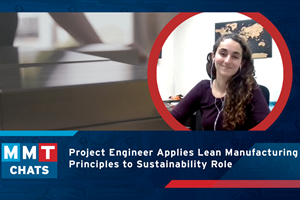Texture Secrets
Of all the tasks polishers face in this trade, texture and its related problems are probably among the most challenging. But with a few tips and tricks, almost any polisher will be able to stand up to this daunting task to produce professional results.
Of all the tasks polishers face in the moldmaking trade, texture and its related problems are probably among the most challenging. Getting hand texturing to match up perfectly with acid bath texturing is a skill entirely unto itself, but with a few tricks of the trade, almost any polisher will be able to stand up to this daunting task and produce professional looking results.
In The Beginning
You should start out with a milled or EDM'd surface. Milled surfaces are simply stoned flat with draw on the sidewalls and to the required finish grit. EDM'd surfaces, on the other hand, are quite a bit different. The problem with EDM'd surfaces is the hardness of the EDM itself and the Heat Affected Zone (HAZ), both of which slow down the acid etching process and end up making the finished texture less consistent than it should be. Therefore, it is important to completely remove all of the EDM and the HAZ (which can be anywhere from .001" to .0015" deeper than the EDM).
You can tell if all of the EDM and the HAZ is properly removed by using a copper etching solution and diluting it approximately 50/50 with water. This testing fluid can be easily spread over the area to be textured with a brush, a spray bottle or even tissue paper. After spreading the first layer, wait a minute or two and add more layers until the surface is black. At that point, you have applied enough test fluid for accurate results. What you're looking for is any EDM still in the steel, which will reveal itself as tiny silver or gray dots. Look also for the HAZ, which will show itself as the shape of the electrode and be silver in color.
If the steel being tested will not turn black, you have a surface hardness problem, which may cause the texture to turn out inconsistently, and which may not be fixable unless the entire block is restoned and retextured. This simple test can save a lot of added time and grief. Only once the steel has been tested, the problem areas have been fixed and the surface is consistently black can the etching take place.
Photo Etching vs. Acid Etching
Photo etching is a process where what looks like "islands" are cut into the steel with acid. These islands and blobs usually range around a certain size and look really neat under a magnifying glass. However, you must be careful with photo etching, as there isn't much you can do to fix these islands if you make a mistake. Because the steel has been cut away from the standing "island," the only way to fix any damaged area is to stone it all off and have the area retextured. Fortunately, if an area does have to be retextured, the company that did the original texturing can usually redo it so that it can't be detected.
Most polishers who are asked to fix a damaged area of texture usually will be dealing with acid texturing. This looks like a sandblast or EDM finish in the steel and can be any depth desired - usually between .001" to .003" deep. Some of the more common reasons for retouching texture finishes include scratching or nicking the finish or rolling an edge so that now it is flashing.
The way to fix an area that has been scratched or nicked is to try to reproduce the same texture finish using different punches, which must be a variety of sizes and contours. Experience has proven that no less than six or seven differently shaped punches are needed for a professional job.
When making up punches for a job, there are several things that must be done. First, it is critical that a "test block" be used. A test block is a piece of scrap that is the same hardness and material as the actual block being fixed - all experimenting should be done on the test block until a perfect copy can be made and only then should the techniques be used on the actual block itself.
Once you have a test block ready, the next tool you need is some putty, such as Silly Puttyr. The only way to test a texture finish is not to look at the steel but to look only at the resulting impression in some putty. If you don't use putty to test with, you will never get it right - and that's all there is to it.
The next step is to get some punches - by buying from a supplier, using lettering punches or making your own from oil hardening rod stock - and begin by trying to identify the three most predominant shapes in the texture. Experience has taught that most texturing is primarily three certain sizes and depths of marks covered over by many variations of these three marks. Begin by identifying these primary shapes and making punches to copy them - use your test block and putty to perfect these shapes and depths. You also should be getting your hand accustomed to how hard you need to hit the punch in order to get the average depth mark you want. As you make other punches to shape, start overlaying them on top of each other to see what kind of finished pattern you end up with. It is possible that you may use one punch more than the others.
A real secret to skilled texturing is to roll the punch between your fingers like a pencil and swing it around from your wrist so that all of the different edges hit into the steel. This will give you a real variation in the finish, which is what texturing is all about. This is not an easy skill to learn, but it is extremely useful and the polisher who can do it well will always be held in high regard.
Fixing Rolled Textured Edges
Probably the most difficult of all texture repairs is fixing edges that have been rolled off. This usually happens when there is a mistake in fitting or when the vents go in too deep. Here are a few ways to fix even these tough problems.
Problem #1
While fitting a side action, the corner in the cavity block has been rolled with a .030" radius right on the edge. It's an appearance part and the customer demands no welding on the textured surfaces - what to do? The answer is to swing the edge forward like a gate on a hinge. Welding is not an option in this case because weld is often harder than the original steel. Even pre-heating, microwelding and post heating will not be satisfactory in a textured environment, as the weld mark will still show up in the finished parts.
The correct solution is to swing the virgin steel forward like a gate on a hinge and fill in weld behind the moved steel. Begin by taking a cut off the wheel and grinding a slot about 1/2" deep behind the steel to be swung forward. Make sure that there is the proper amount of steel thickness to withstand the movement at the base of the slot so the swinging steel doesn't snap off! It's better to make this slot too deep instead of not deep enough. The more steel that can bend over a larger area, the less likely it is to snap off.
Now take a "drift" punch (anything with the proper angle on it to spread the walls apart as it's slowly driven in) and carefully begin to move the steel forward by lightly driving the drift punch in behind it. If you have done everything right and the "hinge" is the correct thickness, then the steel should swing forward easily without creating stress in the hinge. If this makes you nervous, practice on a scrap piece until you feel comfortable.
After the steel has been moved forward enough that the proper amount of virgin stock is in place for the reblending, put a small wedge of steel into the slot opening and leave it there. This will keep the "gate" from swinging back as the slot behind it is being filled up with weld. Failure to do so may result in the moved steel traveling even farther back than when you started! And now that it's been welded once, there is a concern that the steel may have become crystallized to the point where you can't swing it again without breaking it off. Once the wedge is in place and everything is welded, you should have enough virgin steel to refit and texture without any weld, as the texture will be on virgin steel.
Problem #2
A vent has been put in too deep and now the parting line is flashing. What is the best way to fix it without welding the edge? The answer again is to cut a slot behind this area and drive it forward. As before, a slot of a depth which will allow the steel to move forward without cracking or breaking must be cut. Drive the steel forward with a drift punch as before and place a "holding wedge" into the slot behind it. Weld, refit and bench to a sharp edge and retexture - no one will ever be able to tell by looking at the part.
Summary
These techniques have proven their worth time and again. However, it is important to obey the following rules carefully:
- If you don't use putty to test the punch impressions, you won't be able to recreate the texture - it just won't come out the same, no matter what.
- Make multiple punches and test them on an equally hard piece of scrap steel to check the "range" of marks, sizes, shapes and depth. Texture is a mixture of many sizes and shapes, and to get it right you need to recreate all of them.
- Any time you are touching up a textured area near a side wall or any other critical area, use a piece of .010" or more shim stock as a protective shield. It only takes a second and can easily save another disaster from happening.
- If swinging an edge of steel makes you nervous, practice on a scrap piece.
- Always place wedges behind the moved steel to prevent it from swinging back.
These techniques have helped mold-makers perfect their texturing, and once mastered, they should help you to do the same.
Related Content
FAQs: What Are the Leadtime Leader Awards?
Here are answers to some frequently asked questions about MoldMaking Technology's annual Leadtime Leader Awards competition.
Read MoreMMT Chats: Project Engineer Applies Lean Manufacturing Principles to Growing Sustainability Role
MoldMaking Technology Editorial Director Christina Fuges catches up with MMT’s 30-Under-30 Honoree Katherine Pistorius, who has added Regional Sustainability Coordinator alongside her Project Engineer duties, which demonstrates the many paths one can take in a manufacturing career. Here she shares how this opportunity unfolded for her and what the job entails today and in the future. This episode is brought to you by ISCAR with New Ideas for Machining Intelligently.
Read MoreThink Safety: Eliminate Hazards Throughout the Shop
The tooling community is taking advantage of new products for safer mold shops and molding facilities.
Read MoreVIDEO: What You Need to Know about the R&D Tax Credit Today
A team member from Strike Tax Advisory reviews the tax changes that are impacting the R&D credits for mold builders.
Read MoreRead Next
How to Use Strategic Planning Tools, Data to Manage the Human Side of Business
Q&A with Marion Wells, MMT EAB member and founder of Human Asset Management.
Read MoreReasons to Use Fiber Lasers for Mold Cleaning
Fiber lasers offer a simplicity, speed, control and portability, minimizing mold cleaning risks.
Read More







.jpg;maxWidth=300;quality=90)











.jpg;maxWidth=970;quality=90)